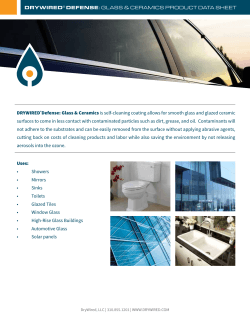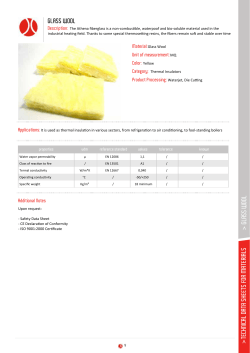
GLASS COATINGS ON THE BASIS OF Na2O-B2O3
CHEMISTRY & CHEMICAL TECHNOLOGY Vol. 9, No. 1, 2015 Chemical Technology Lyidmyla Bragina and Yuliya Sobol GLASS COATINGS ON THE BASIS OF Na2O-B2O3-SiO2 SYSTEM FOR TIN BRONZE PROTECTION DURING MELTING National Technical University “Kharkiv Polytechnic Institute”, 21 Frunze str., 61002 Kharkiv, Ukraine; ulya-sobol@ukr.net Received: February 20, 2013 / Revised: March 11, 2013 / Accepted: September 29, 2013 Bragina L., Sobol Y., 2015 Abstract. Requirements to properties of protectivetechnological coatings for the tin bronze melting from secondary raw materials were formulated in the work. The choice of model glasses compositions in the initial Na2OB2O3-SiO2 system on the basis of the melting parameters values was made. Non-scarce and inexpensive raw materials for protective coatings were selected. Also the best glass composition was determined based on the complex of chosen properties. The formation mechanism of the selected composition glassy melting by using DTА and XRDА was studied. Keywords: technological glass coatings, secondary raw materials, oxidation, tin bronze, protection, melt. 1. Introduction Unique properties of bronze provide a diverse usage of products made of it: from jewelry, tableware and elements of decor parts to precision instruments and armature (faucets, bolts). Due to corrosion resistance and antifriction properties bronze elements are used as details of lots of machine and mechanism units, particularly engines. The increasing demand for bronze products and intermediate goods stimulates production of this type of alloy and its casting. However, large burn-off losses and with slags in the form of drop-wrens that depending on the way of fusion and raw materials may reach 5–12 %, takes place during bronze melting [1]. Lack of copper, which is the base of this alloy, and alloying additives that are used in bronze production in Ukraine, leads to the need of using contaminated chip and scrap as batch compound. This fact considerably complicates the technology of qualitative casting obtaining [2, 3]. Applying of fluxes and covers is known as the simplest, less expensive and effective way of bronzes protection from oxidation and their melt refining. Cryolite, charcoal, borax, fluorspar, soda ash, chlorides, and others are the basis of fluxes. However, they do not provide sufficient protection of metal melt from oxidation and quality of bronze products. In addition, they mostly contain toxic and scarce components or are aggressive in relation to melting furnace refractory lining [4, 5]. Glass materials of specific composition on the basis of nontoxic and non-scarce components can be an alternative to the mentioned fluxes. Development of coating compositions that provide high degree of the tin bronze melts protection and at the same time are non-aggressive to furnace refractory linings on the basis of such glass materials is a scientific and technical goal. Results of the researches carried out for the purpose to realize this goal are presented in this article. 2. Experimental 2.1. Synthesis Criteria of Technological Glass Coatings Known requirements to protective-technological coatings (covering fluxes) for the tin bronze melt [1, 4] are insufficiently concrete and not full for working out and using of glass materials with similar purpose. In particular, they do not include limiting values of dynamic viscosity, fusibility, surface tension, density, thermal conductivity, and heat capacity of glass melts and other properties in the range of the bronze fusion. Therefore, at the first stage of carrying out of the given work a complex of synthesis criteria of such coatings with the use of results of the previous researches concerning oxidation of tin bronze [6] and experience in the field of protection ferrous and nonferrous metals and alloys with glassceramic and vitreous enamel coatings [7] has been developed. 112 Lyidmyla Bragina et al. Additionally, real temperature-time melt modes of different in composition tin bronzes from secondary raw materials at periodic and continuous methods of manufacture, necessity of reduction of heat losses from a heel of metal by radiation and certain temperature maintenance throughout the volume of the melting furnace, as well as the speed defined parameters of the liquid glass flux formation and its protective properties were considered. In this connection the technological glass coatings for tin bronzes protection during fusion should be characterized by the following complex of properties and limits of their values: – form and protect tin bronze in a temperature interval of intensive oxidation and fusion of 948–1423 K; – the minimum gas permeability to prevent oxidation and metal saturation by hydrogen in the conditions of fusion and contact with batch which continuously moves on a metal melt surface; – dynamic viscosity η within 103–104 Pа⋅s at the heat temperatures close to those of bronze fusion for formation of a continuous layer of protective glass melt; – flowability d =30–35 mm in the above-stated interval of temperatures; – density ρ that is considerable smaller than the density of tin bronze 8700–8800 kg/m 3; – value of wetting angle of bronzes θ ≤ 20° at temperature of their fusion; – value of surface tension σ within 260–290 mN/m; – temperature coefficient of linear expansion (TCLE, α293-673 K) of coatings in a solid state lower than TCLE of bronze (αbronze = 166⋅10-7 –183⋅10-7 1/K); – inertness in relation to quartziferous (quartzitic) or aluminosilicate (chamotte) refractory lining of melting furnace and absence of active interaction with tin bronze; – minimum values of heat capacity Ср and thermal conductivity λ coefficients below such for bronze (Ср bronze = 0.38 kJ/kg⋅K and λbronze = 94 W/m⋅K) for reduction of an intensive heat exchange between metal melt and environment. – additional conditions concerning manufacturing of coatings from inexpensive raw materials which would be ecologically safe for people and environment during their application are provided. 2.2. Materials and Methods The water glasses with different silicate modules, borax and cullet of glass container were used as components of glass composition for obtaining of protective-technological coatings. Materials were ground to fineness which corresponded to passage through a sieve of 144 op./sm2; weighing operation were made on technical laboratory scales according to glass compo- sitions, scrupulously mixed for achievement of sufficient degree of uniformity. Drying of the samples was carried out in laboratory oven SNOL with 1.5 kW/h capacity. The interval of fusibility and wetting angle were defined by techniques URGTU (NPI), flowability – by a specially developed technique. Viscosity, temperature coefficient of linear expansion, surface tension, and density were counted by techniques and formulas of V. Goleus and I. Makhovsky [8] and A. Appen, heat capacity and thermal conductivity − according to V. Zimin’s data [9]. Phase composition of glass coatings at heating was defined on X-ray diffraction spectra (XRDA). The differential-thermal analysis (DTA) of glass composition at heating till the bronze melting temperature were carried out on derivatograph OD-103M. Calculation of results and their processing were executed using methods of mathematical planning of experiments and computer software packages Mathcad and Statistica. 3. Results and Discussion 3.1. Choice of Initial System and Areas of the Model Glasses Compositions in it for Protective-Technological Coatings Obtaining In order to choose an initial oxide system for synthesis of model glasses the necessity of the secondary bronze refinement with the protective coating silicate melts from refractory oxide compounds and impurities was considered. It is necessary to underline a special role of B2O3 oxide which, having an acid character interacts with metals oxides, in particular copper, and transforms them into metaborate. It was also taken into consideration that the presence of boron anhydride as a component of enamel and glass lubricating coatings for protection of ferrous metals against corrosion and during technological heats and hot deformation of the blocks [7] is caused by its ability to reduce surface tension, improve elasticity of enamels and to dissolve iron oxides [10]. Therefore on the basis of known data concerning synthesis of protective glass coatings, phase diagrams of silicate systems and according to requirements to protective-technological glass coatings for the tin bronze melts, formulated above, the system Na2O-B2O3-SiO2 was taken as an initial one, which is presented in Fig. 1. The choice of this system is caused by possibility of selection of glass compositions with necessary manufacturability, and the values of temperature interval of fusibility ΔT in it. This is important in case of tin bronzes, which depending on their composition have variation of own melting temperatures from 1188 to Glass Coatings on the Basis of Na2O-B2O3-SiO2 System for Tin Bronze Protection During Melting 1373 K. In addition we also considered positive experience of the Na2O-B2O3-SiO2 system glasses use as cover fluxes at heat treatment of ferrous metals, and consequently the ability of such glasses to form dense layers that are low-permeable for oxygen [11]. Besides, according to [12] glass melts formed in this system are low-active in relation to bronze components. Taking into account temperatures of the tin bronzes oxidation and melting [6] 9 model glasses whose compositions are located near fusible eutectics and other invariant points of the Na2O-B2O3-SiO2 system with corresponding temperatures of fusion were selected. Such compositions in the mentioned system are: 1–3 in area A, located in the field of Na2O·4B2O3 113 crystallization with melting point 1088 K, 4–6 in area B, localized in the field of existence of Na2O·B2O3 with melting temperature 1239 K, 7–9 in area C, being between fields of existence of SiO2 and Na2O·2SiO2. The chemical composition of these glasses and their density ρ, melting (tm, η1273, σ1273,) and thermophysical properties (α, λ1273) which values were calculated with additive formulas of A. Appen and V. Goleus and I. Makhovsky, are shown in Table 1. On the basis of the obtained calculated data the expediency of use of 7–9 glasses compositions located in area C of system Na2O-B2O3-SiO2, limited to the following oxides content, wt %: Na2O 24–29; B2O3 3–13; SiO2 59–69, was established. Fig. 1. Na2O-B2O3-SiO2 system: А, B, C – areas of the model glasses compositions Table 1 Chemical composition of glasses and their properties Components content, wt % Glass marking А B C 1 2 3 4 5 6 7 8 9 Properties SiO2 Na2O B2O3 tm, K η1273, Pа·s σ1273, mN/m ρ, kg/m3 α·107, 1/K 20 20 11 31 32 27 60 65 68 10 15 17 32 35 33 27 27 27 70 65 72 37 33 40 13 8 5 973 1003 1043 973 1023 1003 973 1013 1023 101.29 101.21 100.51 101.2 101.16 100.94 102.95 103.21 103.37 139 149 134 202 210 197 246 255 260 2702 2716 2776 2693 2695 2719 2521 2495 2480 57 75 82 134 144.5 138 116.8 116.77 116.7 λ1273, W/(m⋅K) 2.585 2.563 2.663 2.354 2.328 2.398 2.023 1.963 1.926 114 Lyidmyla Bragina et al. The area of these promising model glasses is located between edges Na2O-B2O3 and Na2O-SiO2 in a triangle in tops of which there are compounds Na2O⋅2B2O3, Na2O⋅2SiO2 and Na2O⋅3SiO2 (Fig. 1), i.e. corresponding to industrial products: borax, water glass (silicate-block) and, with certain degree of approximation, to a basis of sodiumcalciumsilicate container and sheet glasses. 3.2. Choice of Raw Materials The main idea that was taken as a principle of the work consists in providing of thermomobility of protective-technological glass coatings - continuous metal protection in a wide temperature-time interval of their application [11], in particular for tin bronzes during their melting due to use of glass components with different values fusible indexes (low-melting and refractory). Such way to obtaining an initial composition of a protectivetechnological coating is chosen similarly to the principle of multifrit compositions development for obtaining glass coatings which are used at enamelling of steel products with a complex shape [7]. While choosing raw materials for protective coating obtaining the following important factors have been taken into consideration: large volume of bronze production, necessity of using cheap, non-toxic and non-scarce in Ukrainian conditions materials. Taking into consideration the above, chemical composition of promising model glasses in system Na2OB2O3-SiO2 and the important circumstance that compounds which limit area of these glasses existence correspond to ready domestic industrial products and wastes of glass manufacture, the following materials have been chosen: soluble sodiumsilicate glass – Na2O⋅nSiO2, or silicate-block (SB), borax (B) as low-melting constituent and broken glass (BG) as a refractory component. For the purpose of choosing a silicate-block with a certain module (M) which corresponds to molar ratio SiO2:Na2O compositions in which the sodium oxide content exceeds 20 mol %, are considered. This is due to microheterogeneity, which is caused by liquation that appears during long heating of sodium silicate glasses at temperatures from above 933 K. The described phenomenon is typical for glasses with Na2O content to 20 mol %. With increasing of the alkaline component quantity in glass they are almost homogeneous [13], that is the important precondition for the formation of continuous protective coatings. In the industry mainly the silicates-blocks with the following modules are produced: 2.37; 2.73; 2.92; 3.44. By the results of researches of melt characteristics of water glasses with the specified silicate modules (Table 2) silicate-block No. 3 with the module M = 2.92 was chosen due to its wide interval of fusibility ΔT = 300 K, sufficient values of flowability d1273 = 30 mm and wetting angle θ1273 = 26°. In samples of silicates-blocks with large content of Na2O (No. 1, 2) after heating the significant amount of a gas phase with the size of bubbles up to 5 mm (see a macrostructure, Table 2) due to dehydration of adsorbed moisture was observed. It can lead to discontinuity of coatings on bronze surface. For optimization of protective glass coating composition the pseudo-ternary diagram SB-BG-B with resulting physicochemical (viscosity, surface tension, wetting angle, flowability), thermophysical (TCLE, heat capacity, thermal conductivity) factors and density for 25 compositions of model glasses were constructed and investigated. Using a simplex-lattice method of planning the graphic interpretation of dependence of the resulted properties from glass composition (Figs. 2 and 3) was received. Table 2 Fusible characteristics of silicate-blocks Composition number, module Tb, K Te, K ΔT, K θ1273, ° d1273, mm 1 М = 2.37 763 1023 260 34 27 2 М = 2.73 768 1053 285 30 28 3 М = 2.92 758 1058 300 26 30 4 М = 3.44 863 1103 240 38 24 Macrostructure of samples, ×9 115 Glass Coatings on the Basis of Na2O-B2O3-SiO2 System for Tin Bronze Protection During Melting 80 20 40 60 60 40 20 40 60 60 60 40 80 20 80 20 80 а) 40 80 20 20 40 60 80 b) Fig. 2. Isolines of physicochemical (а) and thermophysical (b) properties versus the composition of glass coatings: – viscosity; – wetting angle; – TCLE; – density; – surface tension – flowability – thermal conductivity; – heat capacity By a complex of properties the composition of protective glass coating SP19 (Fig. 3) which is characterized by the following values of the listed factors: viscosity η1273 = 103.64 Pа⋅s; surface tension σ1273 = 269.3 mN/m; wetting angle 10°; flowability d1273 = 35 mm; heat capacities Ср1273 = 1.112 kJ/(kg∙K); thermal conductivity λ1273 = 1.898 W/(m⋅K); density ρ = 2478 kg/m 3 was optimized. Owing to the established ratio of initial glass forming components with different values of ΔT the developed glass coating SP19 forms a continuous layer with exclusively wide interval of melting ΔT = 360 K. It is confirmed by character of DTA curve (Fig. 4). At heating in the process of the glass coating SP19 forming weight loss of the sample to 6.1 % in the temperature range of 333–733 K is observed. That is explained by coating loss of water (adsorbed and constitutional) which is present in borax – Na2B4O7⋅10H2O. At more detailed consideration of DTA and TG curves in the given temperature range it is possible to see step character of borax dehydration with the transition temperatures of 333 K, 413 K and 733 K, respectively. At further rising of temperature up to 1273 K practically no change in weight of glass occurs. It testifies to its stability in the temperature interval of 733–1273 K. The phase transformations in the developed glass coating SP19 were investigated by X-ray diffraction method at temperatures which correspond, judging from DTA curve (Fig. 4), to the beginning, maximum and the end of exo-effect. The obtained X-ray diffractograms are presented in Figs. 5-7. In the sample No. 1 (933 K) two main crystal phases α-Na2Si2O5 and α-SiO2 (quartz) are observed. In addition to the specified phases the halo from a material in Fig. 3. The area of glass coating compositions with optimal values of physicochemical and thermophysical properties amorphous state with its maximum at 2θ = 30 degrees is present. The quantity of a crystal phase is at least 15 vol %. On the X-ray diffractogram of the sample No. 2 (Fig. 6) there is brightly expressed halo from glassy phase with maximum on the first order of reflection at 29 degrees, on the second – at 45.5 degrees and on the third – at 61 degrees. Moreover, in the investigated material the indistinct peaks from the crystal phase, whose content in a sample does not exceed 5 vol % were observed. It may be related to NaBSi3O8 and α-Na2Si2O5 phases. The width of peaks from crystal phase testifies to the small size of coherent-scattering region (CSR) for it. The size of CSR was calculated with use of the Selyakova-Sherrera’s equation and is approximately 8 nm. 116 Lyidmyla Bragina et al. Fig. 4. Thermogram of glass coating SP19 Fig. 5. X-ray diffractogram of glass coating SP19 to 933 K Fig. 6. X-ray diffractogram of glass coating SP19 at 1033 K Fig. 7. X-ray diffractogram of glass coating SP19 from above 1083 K In the sample No. 3 (1083 K) the main component is amorphous structure – glass whose content is not less than 97 vol %. As a suppositional crystal phase, from which indistinct reflexes of weak intensity are observed, is α-Na2Si2O5 (Fig. 7). These data indicate that composition of the developed glasscoating SP19 at heating is changed in the whole temperature interval of its service. Consecutive formations and fusions of crystal phases simultaneously with vitreous phase melting allow to regulate viscosity value of glassy melt for the lower gas permeability and as a result to reduce diffusion of oxidizing agents through it to the tin bronze melt. Glass Coatings on the Basis of Na2O-B2O3-SiO2 System for Tin Bronze Protection During Melting 4. Conclusions The mechanism of the developed glass composition SP19 formation for tin bronzes protection during their melting was established by the data of fusible indexes, DTA and XRDA. It consists in consecutive fusion of its components with the following crystallization and melting of new phases: α-Na2Si2O5 (sodium disilicate) and NaBSi3O8 (reedmergnerite). This allows to regulate viscosity of glass melt to ensure its continuity and lower gas permeability for the furnace atmosphere agents, which plays determinant role in significant reduction of bronze losses due to oxidation and burn-off loss. References [1] Pikunov M.: Plavka Metallov. Kristallizatsiya Splavov. Zatverdevanie Otlivok. MISIS, Moskwa 1997. [2] Popov V., Smolyakov V., Gorshkova V. et al.: Inf. Bull. Lityo Ukrainy, 2011, 10, 134. [3] Kurdyumov А., Pikunov М., Chursin V. et al.: Proizvodstvo Otlivok iz Splavov Tsetnykh Metallov. MISIS, Moskwa 1996. [4] Davis J.: ASM Specialty Handbook: Copper and Copper Alloys. ASM International, Ohio 2001. [5] Chastain S.: Metal Casting: a Sand Casting Manual for the Small Foundry, v. II. Chastain publishing, Florida 2004. [6] Braginа L., Sobol Yu., Sobol N. et al.: Vestn. Nats. Techn. Univ. Kharkiv. Polytech. Inst., 2006, 12, 134. 117 [7] Bragina L. and Zubehin A. (Eds.): Tekhnologiya Emali i Zashchitnykh Pokrytiy. NTU «KhPI», Kharkov 2003. [8] Goleus V.: Inform. Vestnik Ukrainskoy Assotsiatsii Emalirovshchikov, 2008, 2, 20. [9] Matveev М., Matveev G. and Frenkel B.: Raschety po Khimii i Tekhnologii Stekla. Stroyizdat, Moskwa 1972. [10] Pagliuca S. and Faust W.: Porcelain (Vitreous) Enamel. Tipografia Commerciale srl, Mantova 2011. [11] Bragina L.: Proceed. 20th Int. Enamellers’ Congress, Turkey, Istanbul 2005, 23. [12] Poruchikov Yu., Mysik R. and Titova A.: Razlivka Medi i Mednyh Splavov pod Zhidkimi Shlakami. TsNIItsvetmet, Moskwa 1981. [13] Appen A.: Khimiya Stekla. Khimiya, Leningrad 1974. СКЛОПОКРИТТЯ НА ОСНОВІ СИСТЕМИ Na2O-B2O3-SiO2 ДЛЯ ЗАХИСТУ ОЛОВ’ЯНИХ БРОНЗ ПРИ ПЛАВЛЕННІ Анотація. Сформульовано вимоги до властивостей захисно-технологічних покриттів для виплавлення олов’яних бронз з вторинної сировини. За значеннями плавкісних показників здійснено вибір складів модельних стекол в вихідній системі Na2O-B2O3-SiO2 та підібрано недефіцитні та невартісні сировинні матеріали для захисних покриттів, а також знайдено кращий за комплексом обраних властивостей склад склокомпозиції. За допомогою ДТА та РДА вивчено механізм формування склорозплаву обраної композиції. Ключові слова: технологічні склопокриття, вторинна сировина, окиснення, олов’яні бронзи, захист, плавлення. 115 Glass Coatings on the Basis of Na2O-B2O3-SiO2 System for Tin Bronze Protection During Melting
© Copyright 2025









